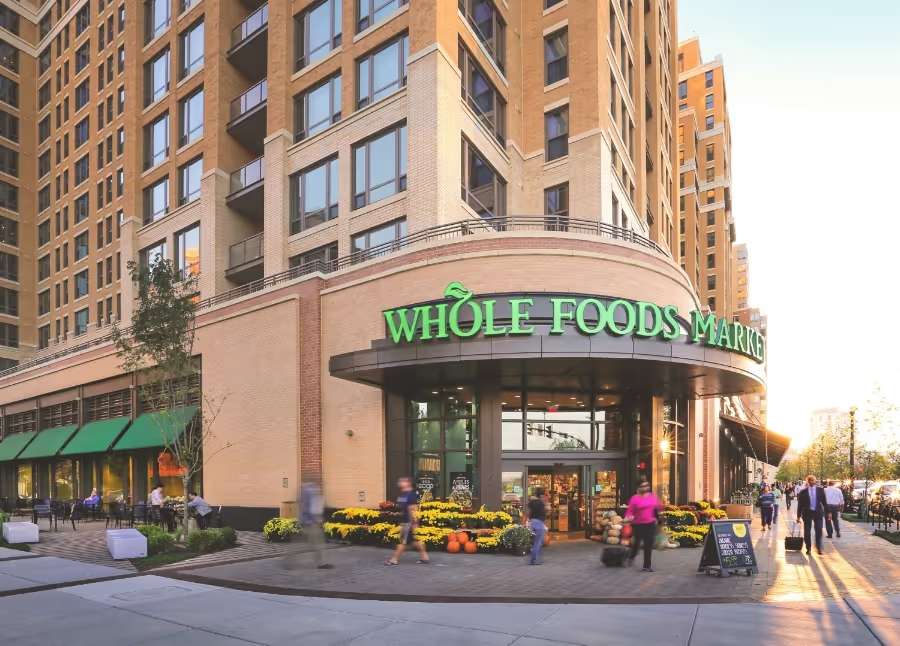The Digital Decoupling of Experience and Infrastructure

Picture an average worker at an online retail product fulfillment center, living a middle class lifestyle. When she goes to the grocery store, she parks her car in a lot that includes decorative paving and landscaping, or maybe she walks down a wide sidewalk lined with trees, street lamps, and benches. On her way to the entrance, she may pass other retail shopfronts, each with carefully crafted displays designed to draw her interest. She enters the store through a well lit glass doorway under a canopy marked by stylish signage and rich finishes. This is a consumer-oriented front-of-house experience.

When she goes to her job working at the fulfillment center, she drives for 90 minutes to the edge of town, parks her car in a roadside drainage ditch, and walks across a hundred yards of sizzling asphalt. She enters the building through a 20 foot roll-up door, randomly placed on the blank, corrugated metal facade. She is a human in a landscape designed for the tractor trailer. This is the efficiency-oriented back-of-house experience.

Few things have upended the consumer marketplace more than the advent of online retail. The disruption of business as usual has resulted in an economic ripple effect, the full implications of which will take decades to understand. Less widely acknowledged is the effect that this disruption has had on the arrangements of our neighborhoods and streets. The "virtual realm” has come of age, and it has had noticeable, physical impacts on the real landscape.
The transition to online retail satisfies a previously unspoken desire to eliminate the need for commuting from the experience of shopping. The allure of this possibility is rooted in one of our most intractable urban problems. Shoppers have been removed from the point of sale slowly over time by euclidian zoning laws, which separate different land uses from one another, and by sprawling development, which increases the distance between any two places. Until recently, retail consumers had to close the gap by driving, parking, taking a bus, wrestling with shopping bags on a crowded street, strapping large items to the roof of their cars, etc. The convenience of eliminating this step is undeniable, but the relocation of retail to the virtual world was only the latest in a series of transitions which further separate consumers from the real world basis of their purchases. The burden of closing that gap, which has historically been shared between all parties, has been transferred from the buyer to the seller, and more specifically, the seller’s staff. Gone is the human element of the transaction, and all of the serendipitous interactions which came with it.
Online retail has become a formidable competitor to "brick and mortar" retail outlets, and recent market trends show that this is having a visible impact on the physical retail world. In recent weeks, online retail sales have surpassed traditional retail by some measures. The retail real estate market has been consistently soft as the number of consumers setting foot in a physical store declines. On the whole, however, retail is not experiencing a decline. It’s just moving.
In traditional brick and mortar retail, the front-of-house customer experience is separated from the back-of-house stockroom by a simple partition wall. The act of shopping and the support services which make it possible are contained in the same building. In online retail, the front-of-house experience happens on a screen, and the back-of-house facility is a fulfillment center, where products are packaged and shipped for door to door delivery, unseen by the general public.
The physical decoupling of the front-of-house from the back-of-house takes retail, which is a core constituent of urban street activity, and relegates it to the cheaper and more remote industrial districts which have access to rail and expressway corridors, but no necessary proximity to the customers they serve. The outcome of these changes is to exempt a growing segment of the economy and urban development from the tenets of good planning and design, due to the fact that they do not form part of the retail consumer experience. The fulfillment center is out of sight, and therefore out of mind.
This double standard in crafting the urban realm has long dominated urban design in the United States. Ironically, the consumers patronizing front-of-house retail and employees staffing the back-of-house infrastructure are often the same people. Online retail and other online services will ultimately widen the gap between these two different landscapes, resulting in a form of commerce where never the twain shall meet.
The challenge facing this first generation of online shoppers is to find a way to knit these two environments into a single world that is cohesive and habitable by the people who staff and the people who patronize these businesses. To keep our existing neighborhoods vibrant, a replacement for street facing storefront retail needs to be developed. To make future developments hospitable, back-of-house development must be brought into the fold of good urban design in order to provide for the needs of its employees, related economic activity, expandability, and for the sustainability of our civilization. Decoupling, unbalanced by the introduction of new connections and linkages in our human and urban networks, is simply disintegration.
We as a society must consider the impact of these changes now, as they are happening, so we can address them in time to have any choice in how they shape our cities, and our lives. Future posts will explore some of the specifics of how online retail impacts the urban landscape, and some opportunities to form new links between the virtual and the real.








